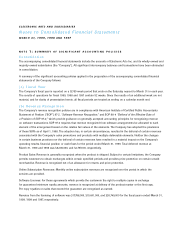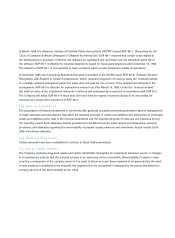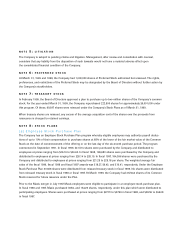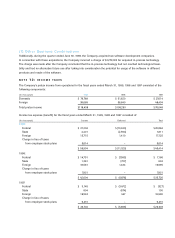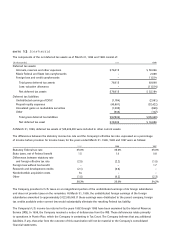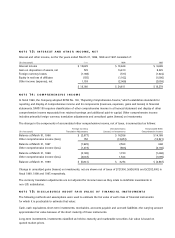Electronic Arts 1999 Annual Report Download - page 37
Download and view the complete annual report
Please find page 37 of the 1999 Electronic Arts annual report below. You can navigate through the pages in the report by either clicking on the pages listed below, or by using the keyword search tool below to find specific information within the annual report.
NOTE 8 (CONTINUED)
(b) Stock Option Plans
The Company’s 1991 Stock Option Plan, 1993 Stock Option Plan, 1995 Stock Option Plan and Directors’ Plan (“Option
Plans”) provide stock options for employees, officers and independent contractors, and for directors, respectively. Pursuant
to these Option Plans, the Board of Directors may grant non-qualified and incentive stock options to employees and
officers and non-qualified options to celebrities, employees of certain companies in which the Company has an equity
investment, and directors, at not less than the fair market value on the date of grant.
Under the Company’s stock option plans, 69,009 shares were reissued from treasury stock in fiscal 1999. No shares were
distributed from reissued treasury stock in fiscal 1998 or fiscal 1997.
The options generally expire ten years from the date of grant and are generally exercisable in monthly increments over
50 months. Certain options assumed in connection with the Maxis merger in fiscal 1998 expire ten years from the date
of grant, and vest and become exercisable at a rate of 25% on the first anniversary of the date of grant and 25% of the
shares each year thereafter.
The Company has adopted the disclosure-only provisions of Statement of Financial Accounting Standards No. 123,
“Accounting for Stock Based Compensation” (“SFAS 123”). Accordingly, no compensation expense has been recognized for
options granted under the Company’s employee-based stock option plans. Had compensation expense been determined
based on the fair value at the grant dates for awards under those plans in accordance with the provisions of SFAS 123, the
Company’s pro forma net income and net income per share for fiscal 1999, 1998 and 1997 would have been:
(In thousands, except per share data) 1999 1998 1997
Net income
As reported $ 72,872 $ 72,562 $ 51,327
Pro forma $ 45,886 $ 52,892 $ 37,343
Earnings per share
As reported—basic $ 1.20 $ 1.23 $ 0.89
Pro forma—basic $ 0.77 $ 0.91 $ 0.66
As reported—diluted $ 1.15 $ 1.19 $ 0.86
Pro forma—diluted $ 0.74 $ 0.88 $ 0.64
The fair value of each option grant is estimated on the date of grant using the Black-Scholes option-pricing model. The
following weighted-average assumptions are used for grants made in 1999, 1998 and 1997 under the stock plans: risk-free
interest rates of 4.39% to 5.55% in 1999, 5.31% to 6.42% in 1998; and 5.48% to 6.36% in 1997; expected volatility of 59%
in fiscal 1999 and 58% in both fiscal 1998 and fiscal 1997; expected lives of 2.27 years in fiscal 1999 and 2.25 years in
fiscal 1998 and fiscal 1997 under the Option Plans and one year for the Employee Stock Purchase Plan. No dividends
are assumed in the expected term. The Company’s calculations are based on a multiple option valuation approach and
forfeitures are recognized when they occur. The above disclosures include options granted under the former Maxis
option plans as if they were initially granted by the Company.
Because SFAS 123 is applicable only to options granted subsequent to March 31, 1995, the impact of non-vested
stock options granted prior to this date has been excluded from the pro forma calculation. Accordingly, pro forma
adjustments are not indicative of future period pro forma adjustments as the pro forma effect will not be fully
reflected until subsequent years.



